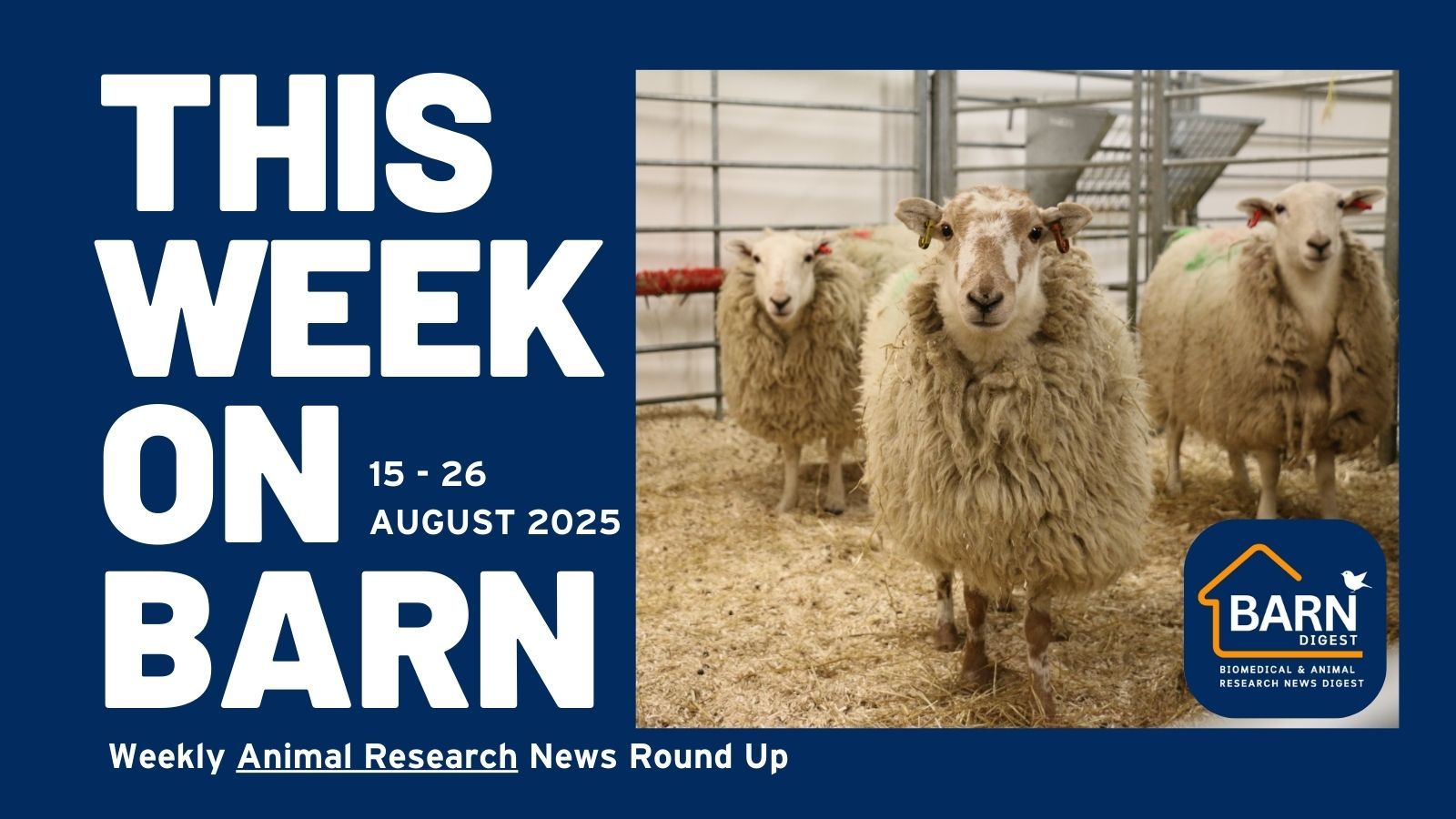
The Biomedical Animal Research News (BARN) Digest collates animal research news from UAR’s 150+ member organisations into one, easy to access, feed. These animal research related stories include topics such as: medical studies and advancements; animal welfare and 3Rs news; funding, regulatory, and policy news; and conservation and environmental research that involves animal testing.
Each week, we pick the most interesting, groundbreaking, and important news to feature in a weekly news roundup. In this round up we feature news stories from 15 - 26 August 2025.
View BARN to see daily news updates from UAR members.
MEDICAL DEVICES
Artificial heart valve found to be safe following long-term test in animals
UNIVERSITY OF CAMBRIDGE, UNIVERSITY OF BRISTOL | SHEEP
"A research team, led by the Universities of Bristol and Cambridge, demonstrated that the polymer material used to make the artificial heart valve is safe following a six-month test in sheep.
Currently, the 1.5 million patients who need heart valve replacements each year face trade-offs. Mechanical heart valves are durable but require lifelong blood thinners due to a high risk of blood clots, whereas biological valves, made from animal tissue, typically last between eight to 10 years before needing replacement.
The artificial heart valve developed by the researchers is made from SEBS (styrene-block-ethylene/butyleneblock-styrene) – a type of plastic that has excellent durability but does not require blood thinners – and potentially offers the best of both worlds. However, further testing is required before it can be tested in humans."
https://www.bristol.ac.uk/news/2025/august/artifical-heart-valve.html
Oxford researchers develop uniquely shaped microstent to combat glaucoma
UNIVERSITY OF OXFORD | PIGS, RABBITS
"A team of researchers at the University of Oxford have unveiled a pioneering ‘microstent’ which could revolutionise treatment for glaucoma, a common but debilitating condition.
The research team used advanced modelling techniques to guide the microstent's design and ensure compatibility with the anatomy of the eye. The device's superelastic properties enable it to accommodate how the eye changes and stretches over time without permanent deformation, enhancing its durability and functionality. "
This study used ocular tissue from pigs, as well as ensuring that the stent was safe and effective in rabbits.
"To evaluate the effect of the deployable microstent on IOP, we designed and 3D-printed the testing setup and performed perfusion experiments on porcine eyes to measure real-time IOP changes pre and post implantation."
"A pilot study using three New Zealand White rabbits was conducted to evaluate the safety, biocompatibility, and effectiveness of the microstent."
https://www.cell.com/the-innovation/fulltext/S2666-6758(25)00138-9
DISCOVERY/BASIC RESEARCH
Blocking brain damage may slow growth of brain cancer
UCL | MICE
“The study, published in Nature and funded by the Brain Tumour Charity and Cancer Research UK, looked at glioblastomas in mice. It found that early-stage tumours damaged parts of nerve cells called axons, and that the brain’s natural response to this injury – breaking down and clearing away these damaged axons – accelerated the tumour’s growth.
Mice in whom this natural response was turned off developed less aggressive tumours, lived for longer and maintained normal brain function that persisted to nearly the end of their lives. In contrast, mice who responded to nerve damage as normal developed more aggressive tumours and progressive disability, the researchers found."
https://www.ucl.ac.uk/news/2025/aug/blocking-brain-damage-may-slow-growth-brain-cancer
Platelets shown to store DNA in study that could transform cancer screening
UNIVERSITY OF OXFORD | MICE
"Oxford-led study uncovers previously unknown function of platelets as DNA ‘vacuum cleaners’ in the blood, with profound implications for cancer diagnosis and prenatal screening."
This study used mice to test their hypothesis.
"Given our hypothesis that platelets clear cfDNA from plasma, we reasoned that plasma cfDNA would increase in the setting of thrombocytopenia. Indeed, acute platelet depletion in an immune thrombocytopenic purpura (ITP) mouse model led to a rise in plasma cfDNA, and patients with ITP and severely low platelet counts exhibited significantly higher plasma cfDNA levels than individuals with normal platelet counts."
https://www.science.org/doi/10.1126/science.adp3971
An unexpected link between pancreatic cancer and dementia could help us beat the disease
CANCER RESEARCH UK | MICE
“Multiple cancer types, including pancreatic cancer, are linked to a faulty mutation in a gene called KRAS. Cells with this mutation are called pre-cancer cells because of their increased risk of developing into cancer.
That’s where Wilkinson’s team started. Using mouse models, they compared healthy pancreatic cells and cells with the faulty KRAS gene to find clues about what has to happen before pancreatic cancer starts.
They studied the mice for several weeks, using different tests and lab techniques to build up a detailed picture of how the pancreas cells changed over time. They also studied human pancreas samples to make sure that what they observed in mice was relevant to pancreatic cancer in humans too.
Throughout their study, they uncovered something interesting – a cellular process unrelated to the KRAS fault was playing a part in the development of pancreatic cancer. "
ANIMAL BEHAVIOUR
Adult jackdaws learn to show tolerance towards youngsters in potentially valuable lesson for humans
"Scientists have found that adult jackdaws can learn to be more socially tolerant towards youngsters. Like many animals, adult jackdaws tend to bully juveniles, muscling them out the way of food and generally not paying them attention. But young jackdaws have much that their elders could learn from – they are more open to new things and ready to exploit the opportunities associated with living alongside humans."
Visit BARN for daily news updates
Last edited: 20 October 2025 13:21




